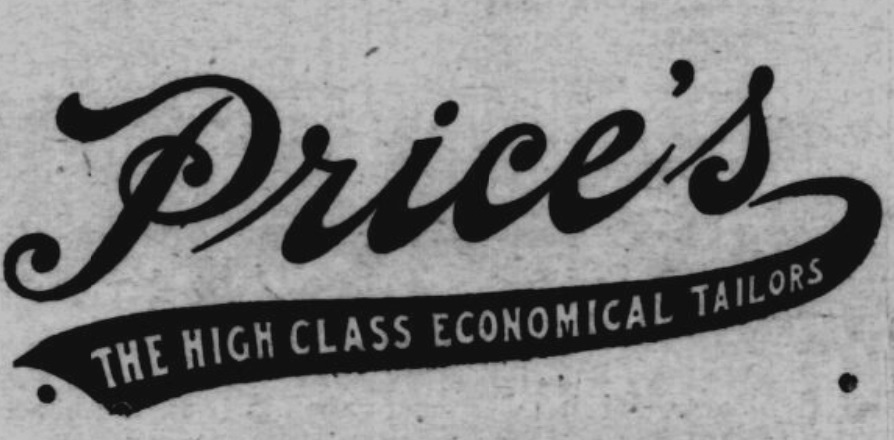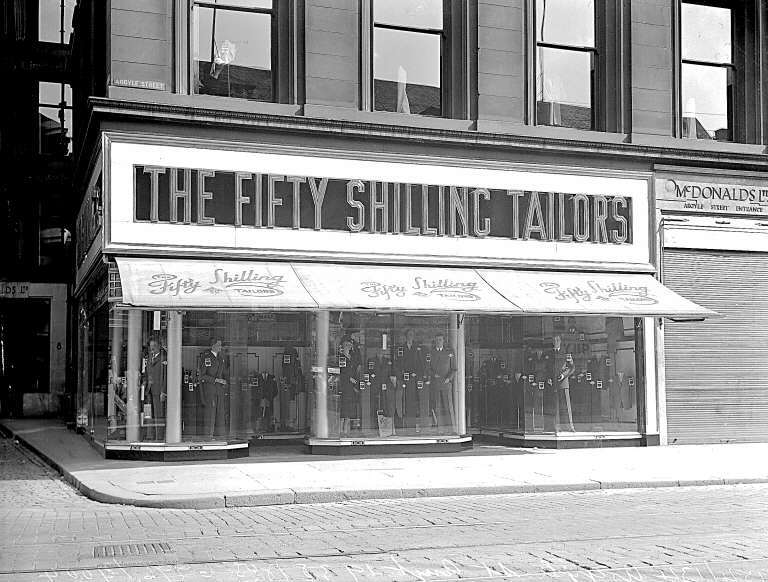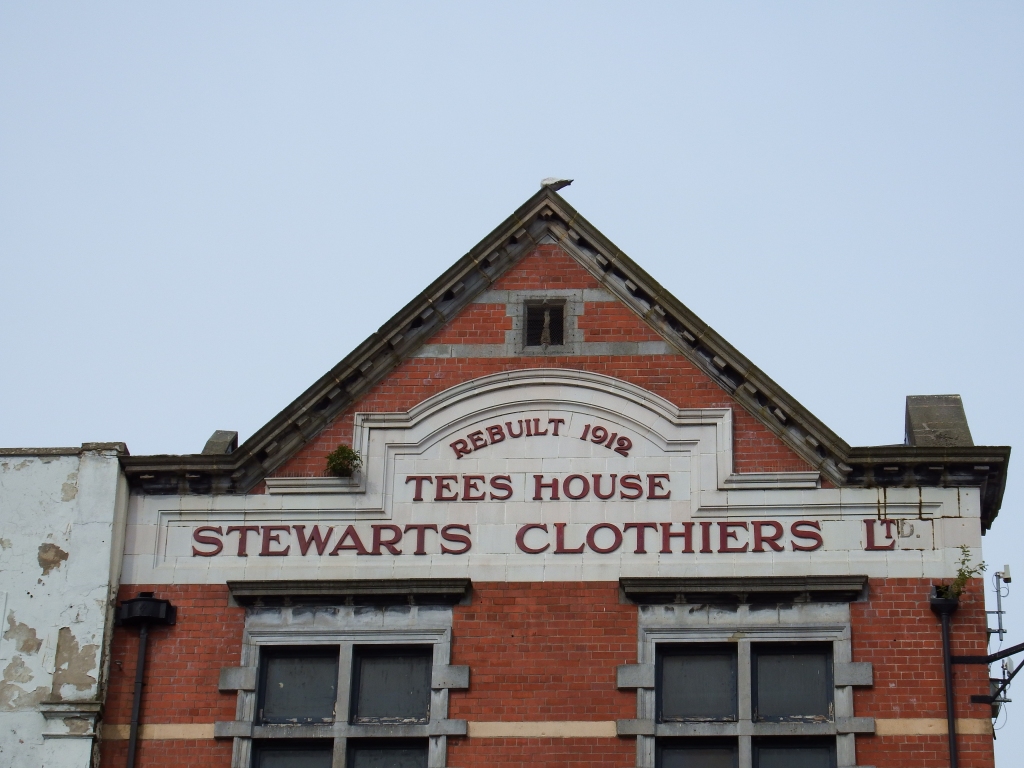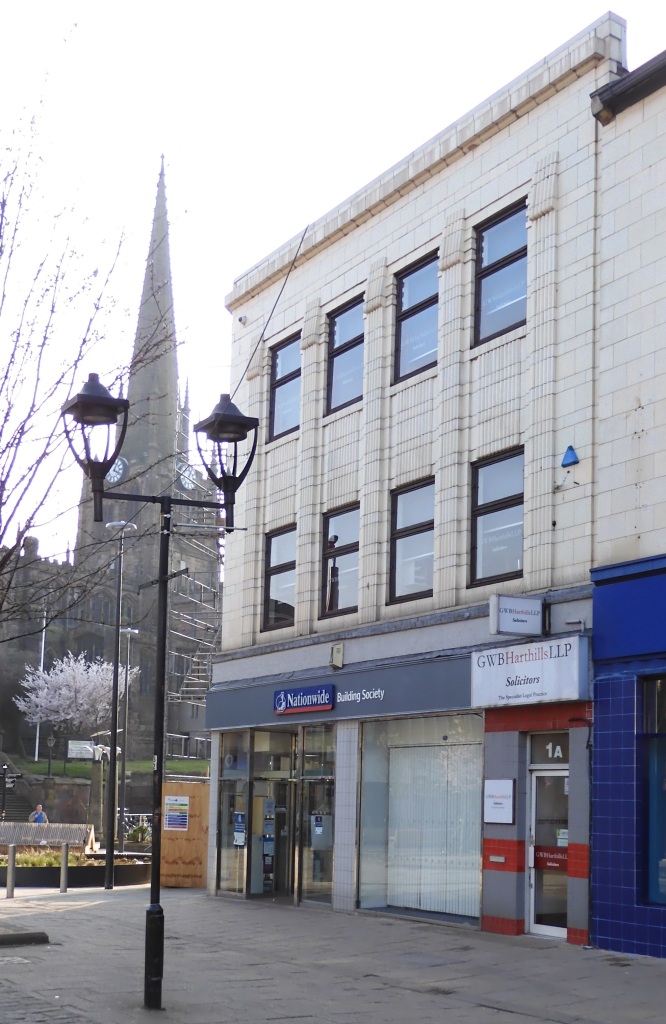
The Fifty Shilling Tailors was one of the most successful ‘wholesale bespoke tailors’ on the British high street through the 1920s, 30s and 40s. In later years, when it became impossible to sell a made-to-measure suit of clothes for a fixed price of 50/-, the shops were rebranded as John Collier.

The business started in 1906 when the founder, Henry Price (1877-1963; knighted 1937), left his job as manager of The Grand Clothing Hall in Keighley to start his own business. By 1914 he had workshops in Keighley and branches of ‘The High Class Economical Tailors’ in Burnley, Wakefield, Halifax and elsewhere. It was common for high-street tailors to add a by-line to their names. One of the pioneers in this sector, Stewart’s, adopted the slogan ‘The King Tailors’, while Burton’s became known as ‘The Tailor of Taste’. In 1913 Price adopted a trademark with his by-line in an underscore, several years before Montague Burton (ahem!) followed suit.

When Prices Tailors Ltd. was created as a private company in 1919 it comprised just 10 shops scattered throughout the North and the Midlands. In 1922 the first shop to trade as The Fifty Shilling Tailors opened in Sheffield. Regardless of their measurements, customers could buy a made-to-measure suit of clothes – a matching jacket, vest and trousers – for 50/-. According to Price, the real value was 5 guineas. Orders were made up at the firm’s Leeds factory following a system Price called ‘rational tailoring’. Four years later, in 1926, Price opened his first London branches in Oxford Street and the Strand. He arrived in Scotland in 1928, followed by Northern Ireland in 1929.

Conversion into a public company, with share issues in 1928 and 1932, aided Price’s expansion. He took over Stewart’s 106 shops, 60 of which were located in towns that lacked The Fifty Shilling Tailors.

By 1934 the business comprised 244 branches under its two fascias. This rose to 270 by the late 1930s, by which time Price’s arch-rival, Montague Burton, had amassed a chain of nearly 600 stores.


Until the mid-1930s most of Price’s shops occupied leased buildings. Then, in 1935, Prices Properties Ltd was set up to acquire sites and lease them to Prices Tailors Ltd. New developments were undertaken by a subsidiary called Cardigan Estates Ltd. The staff architect Philip S. B. Nicolle produced a house style for new stores. Steel-frame buildings with concrete floors were clad in cream faience with rugged geometric decoration in the art deco style. Commercially, this was a clever design. Its surprisingly traditional fenestration made it adaptable to sites of all shapes and sizes and allowed upper-floor functions to vary according to need. Furthermore, unlike Burton’s stores, it was free – at least, above the shopfront – from any kind of permanent branding. These were buildings that would retain their value and could easily be sold to other businesses if need be. As well as erecting these standalone stores, Price embarked upon ambitious city-centre development schemes, for example building a parade of five shops in Granby Street, Leicester, in 1934.



The gleaming arcade shopfronts of The Fifty Shilling Tailors had neon-tube lettering mounted on black Vitrolite, chrome edging, and transom lights etched with the firm’s lozenge-shaped trademark. Two dummies often stood in the windows, one fat and the other thin, with the legend ‘No extra charge’. These were amongst the flashiest shopfronts created by any multiple tailor and did not always meet with approval. In Sevenoaks, for example, the Council sought to modify Nicolle’s enormous brilliantly-coloured lettering which, for them, represented the ‘vulgarisation of the high street’.

Henry Price abandoned the name The Fifty Shilling Tailors in 1950. He announced: ‘it would be merely wishful thinking to expect that such a price as 50s. for a suit of clothes can ever return’. His solution was to trade under the abbreviation ‘FST’, with a new logo and shopfront in an art deco style, harking back to the 1930s.

In 1951 Henry Price acquired a Scottish chain that had been established in the early 1920s by Claude Alexander (1901-53), whose father and uncles had founded Alexander the Great Tailor in the 1890s. Alexander’s 44 shops traded as ‘The Scottish Tailor’.


In 1953, however, Price’s business – with 356 shops deemed ‘the second largest bespoke tailoring business in the world’ – was sold to United Drapery Stores (UDS). A year later, UDS acquired Alexandre’s (not to be confused with Alexander’s!). Its founder’s sons, Jack Lyons (1916-2008) and Bernard Lyons (1912-2008), steered UDS’s menswear chains through subsequent decades.
The name over Price’s shops was changed to John Collier at an estimated cost of £1 million from 1956. Joseph – not John – Collier (1898-67) was the vice-chairman and managing director of UDS. Under staff architect Evan E. Morgan, experimental versions of the new shopfront were tried out in several towns before the design was finalised. Deep fascias were mounted with the name in signature style, as if it had just rolled off John Collier’s pen. The striking 1950s house style was gradually diluted and the names John Collier and Alexandre both disappeared in the 1980s.

The shopfronts of The Fifty Shilling Tailors have long gone, but many of its faience facades survive, for example in Leicester, Rotherham, Dewsbury, Nuneaton and St Albans. They may not be as distinctive or numerous as Burton’s better-known stores, but they encapsulate the typical chain-store style of the 1930s high street. If I haven’t mentioned one in your own town, please tell me about it in the comments below.
With thanks to Matthew Bristow for researching Price’s St Albans store.

My dad was manager of Fifty Shilling Tailors Barrow-in-Furness from the late 40’s to 1953, he then returned to Liverpool and managed the shops in London Road and Lord St. In the early 60’s he transferred to a new John Colliers in Kirkby, Merseyside from where he retired in the 1970’s. I have photos of the shop.
LikeLike
Hi…that turned out to be a great read for me. I have an old John Collier suit – certainly 50’s in style. It has a printed paper label in one of the inside pockets – I think this may say Friday. So I was very curious to learn exactly when the John Collier brand emerged. This turns out to be 1956. Really great info, many thanks
k
LikeLike
Pingback: Kew in the Country – thebluepolarbear
A great read. I had postcards from an employee of Stewart’s who travelled to work at least 3 different shops around 1912 / 15. Fascinating seeing lives , businesses and change.
LikeLike
My uncle said when his uncle was a footballer for Morton ,motherwell Falkirk and Scotland he was a model for fifty shilling suits.his name is Robert keyes from the plains Coatbridge Lanarkshire can you tell me if this is true
LikeLike
Pingback: Shrewsbury – Welsh or English? | Stirlingretail